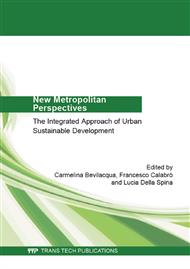p.594
p.600
p.607
p.614
p.621
p.625
p.634
p.639
p.647
Transfer of Development Rights as Incentives for Regeneration of Illegal Settlements
Abstract:
In Italy, southern cities are often characterized by widespread phenomena of illegal settlements, that have resulted among other things in a worsening of the quality of life of the urban-rural interface, and the decline of the considerable architectural interest of the entire city. .The goal of this paper is to propose an approach that would help requalify what is already built, to make the best of what has been realized by focusing on the quality and liveability of the city. This approach is based on a particular methodology based on the promotion of Urban Complex Programs (PUC), which provide a system of development rights resulting from the demolition of unfinished illegal settlements . The benefits of this approach are many, including improvements in efficiencies and safety, meeting demands of environmental protection and reducing consumption of energy, responding to the highest standards of protection and seismic risk prevention. They can be obtained only on one condition: that they are based on a system of collective and public conveniences in accordance with the principle of sustainability in multiple dimensions (environmental, cultural, technological, political, institutional, social and economic). But for this approach to be viable it needs also to be convenient for the private actors as well. With this paper we hope to provide first an original approach that can improve the conditions of cities burdened with the problems of illegal settlements that is both sustainable and convenient and, second, an instrument that can provide information for both the public and private sectors on the fairness of the procedure and their mutual interest in pursuing this approach.
Info:
Periodical:
Pages:
639-646
Citation:
Online since:
June 2014
Authors:
Permissions:
Share:
Citation:


